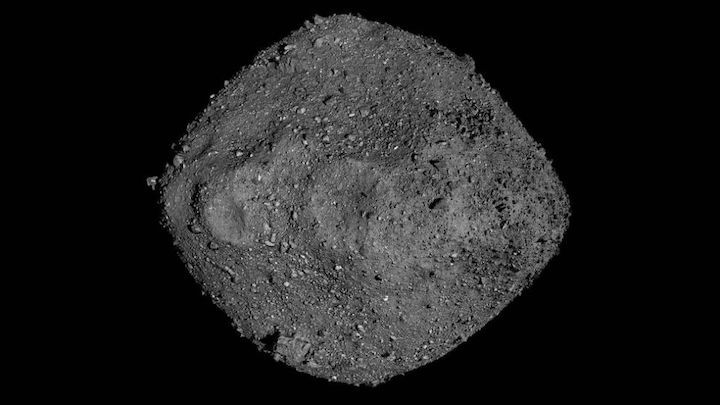9.04.2022
The surface of asteroid Bennu acts like an impact-absorbing crumple zone.

Scientists have created a detailed topological map of asteroid Bennu. (Image credit: NASA)
The surface of asteroid Bennu is riddled with craters. But data from NASA's OSIRIS-REx mission show that, in fact, many craters are missing. The findings suggest that some unexpected geological processes are underway on the 0.3-mile-wide (0.5 kilometers) space rock recently visited by the American space probe.
NASA's OSIRIS-REx spacecraft spent nearly two and a half years between 2018 and 2021 studying near-Earth asteroid Bennu. While the probe won't deliver its small pieces of that space rock to Earth until next year, scientists have already analyzed thousands of images and troves of data gathered by the spacecraft.
This amount of data and images has made Bennu one of the best explored bodies in the solar system, Edward "Beau" Bierhaus, a space science researcher at Lockheed Martin and lead author of a new paper detailing the findings told Space.com.
"We've collected thousands and thousands of images and literally billions of LIDAR measurements that give us the topographic shape of Bennu," Bierhaus said. "Now we have the most detailed topographic map of any body in the solar system."
Bierhaus and his colleagues spent months going through those images with the aim to learn more about how craters form on the asteroid, and what the researchers found surprised them.
The 1,590-foot-wide (484 meters) Bennu is pockmarked with craters — the scientists found over 1,500 of them, ranging from 3 feet (1 m) to 660 feet (200 m) wide. But then the researchers compared these numbers with data about the frequency and intensity of crater-forming collisions on Earth, the moon and other bodies. Those calculations show that the scientists should have found many more such impact scars.
"Statistically, we would expect to see many more small craters," Bierhaus said. "But they are not there."
Missing craters
Scientists base their understanding about crater-forming asteroid collisions on observations of surfaces of rocky planets, like Mars and Mercury, or the moon. Without a proper weather-producing atmosphere and little to no volcanism, these barren worlds keep an accurate record of their past battering.
But on Bennu, things don't seem to work the same way.
Bierhaus said that what the scientists found on Bennu was somewhat similar to what Japanese spacecraft Haybusa discovered on the asteroid Itokawa, which it visited in 2005. That asteroid, somewhat smaller than Bennu, didn't have many craters at all, Bierhaus said.
"We think this absence of small craters has to do with the character of Bennu's surface," said Bierhaus. "It's extremely rugged, covered with boulders, and very different from the moon or Mars."
Bennu is what scientists call a rubble-pile asteroid: Rather than a solid block of rock, the little world is essentially a clump of boulders, pebbles and sand, all produced in earlier collisions, that are held together only by gravity. This structure, Bierhaus said, works like "the crumple zone in a car," absorbing many impacts, especially less energetic ones, nearly without a trace.
Planetary defense
Scientists call the production of that crumple zone "impact armoring."
"When something hits Bennu, the energy of the impact is not efficiently transmitted into the bulk volume of the asteroid," Bierhaus said. "It might be entirely absorbed by one boulder or a small number of boulders. It's not allowed to propagate into the rest of the surface and make a crater."
Understanding how rubble-pile asteroids behave during impacts is interesting not only from the scientific perspective, Bierhaus said. Scientists believe that the vast majority of near-Earth asteroids — those that could possibly impact our planet — are rubble piles.
If one day a sizable asteroid is found on a collision course with Earth, humankind will have to send an artificial impactor its way, in an attempt to avert the collision. But that's a complicated task.
"Our ability to do this is very dependent upon our understanding of the construction of these objects, how they are put together and how they respond to energetic events," Bierhaus said. "By studying rubble-pile asteroids, we are not only gaining insight into the history and evolution of the solar system, but also into our potential ability to protect Earth."
Youngest surface in the solar system
Bennu has offered other surprises as well. When analyzing the characteristics and distribution of the asteroid's craters, the scientists realized that unlike the moon, Bennu doesn't keep a very long record of its past encounters. On average, traces of past events are wiped out every few million years, and while the asteroid itself is up to a billion years old, its constantly changing surface is relatively young.
"Based on the observed crater population, you can estimate the age of the surface," Bierhaus said. "For Bennu, we got something like 2 million years, and that is remarkable. It's one of the youngest crater-derived surface ages we've seen in the solar system."
The finding challenges some earlier assumptions about the life of asteroids. On these "geologically dead" bodies, without volcanism and weather-producing atmospheres, clearly other phenomena are at work that keep them more alive than one would expect, Bierhaus said.
"We thought we had some basic understanding of all the different ways that impact cratering could manifest," he said. "And it was surprising to look at Bennu and find that there is a whole new regime that we just haven't fully appreciated before."
Quelle: Space.com
